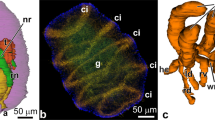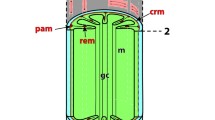Summary
Ultrastructural features of histospecific differentiation were found in early cleavage stage ascidian embryos treated with cytochalasin B and held thereby in cleavagearrest until hatching time. Markers characteristic of tissue differentiation during normal embryonic and larval stages ofCiona intestinalis were expressed in muscle and two brain cell lineages of cleavage-arrested whole embryos and in epidermal and notochordal cell lineages of cleavage-arrested partial embryos. These features were muscle myofilaments and myofibrils, melanosomes of the brain pigment cells, cilium-derived structures present in a “proprioceptive” brain cell, extracellular test material of epidermal cell origin, and the sheath filaments, membrane leaflets, and vacuolar colloid associated with notochord cells. All of these ultrastructural markers of differentiation were blocked in their development by treatment of gastrula stage embryos with actinomycin D, an inhibitor of RNA synthesis, and presumably result from the expression of new gene activity. At the time of cleavage-arrest the five cell lineages studies still contained two or more unsegregated lineage pathways. Subsequent developmental autonomy within the lineages is consistent with the hypothesis of segregation during early development of functionally independent gene regulatory factors.
Similar content being viewed by others
References
Altner H, Zimmermann H (1972) The saccus vasculosus. In: Bourne GH (ed) The structure and function of nervous tissue 5. Academic Press, New York, pp 293–328
Caplan AI, Ordahl CP (1978) Irreversible gene repression model for control of development. Science 201:120–130
Cloney RA (1964) Development of the ascidian notochoid. Acta Embryol Morphol Exp 7:111–130
Cloney RA, Cavey MJ (1982) Ascidian larval tunic: extraembryonic structures influence morphogenesis. Cell Tissue Res 222:547–562
Conklin EG (1905) The organization and cell lineage of the ascidian egg. J Acad Natl Sci [USA] 13:1–119
Conklin EG (1929) Problems of development. Am Nat 63:5–36
Crowther RJ, Whittaker JR (1983) Developmental autonomy of muscle fine structure in muscle lineage cells of ascidian embryos. Dev Biol 96:1–10
Davidson EH, Britten BJ (1971) Note on the control of gene expression during development. J Theor Biol 32:123–130
Dilly PN (1964) Studies on the receptors in the cerebral vesicle of the ascidian tadpole. 2. The ocellus. Quart J Micr Sci 105:13–20
Dilly PN (1969) The ultrastructure of the test of the tadpole larva ofCiona intestinalis. Z Zellforsch 95:331–346
Eakin RM, Kuda A (1971) Ultrastructure of sensory receptors in ascidian tadpoles. Z Zellforsch 112:287–312
Gianguzza M, Dolcemascolo G (1980) Morphological and cytochemical investigations on the formation of the test during the embryonic development ofCiona intestinalis. Acta Embryol Morphol Exp 1:225–239
Jansen WF, Burger EH, Zandbergen MA (1982) Subcellular localization of calcium in the coronet cells and tanycytes of the saccus vasculosus of the rainbow trout,Salmo gairdneri Richardson. Cell Tissue Res 224:169–180
Jeffery WR, Meier S (1983) A yellow crescent cytoskeletal domain in ascidian eggs and its role in early development. Dev Biol 96:125–143
Katz MJ (1983) Comparative anatomy of the tunicate tadpole,Ciona intestinalis. Biol Bull 164:1–27
Lillie FR (1902) Differentiation without cleavage in the egg of the annelidChaetopterus pergamentaceus. Wilhelm Roux's Arch 14:477–499
Luft JH (1961) Improvements in epoxy resin embedding methods. J Biophys Biochem Cytol 9:409–414
Mancuso V (1969) L'uovo diCiona intestinalis (Ascidia) osservaio al microscopio elettronico I. Il cell-lineage. Acta Embryol Exp 1969:231–255
Mancuso V (1973) Changes in fine structure associated with the test formation in the ectoderm cells ofCiona intestinalis embryo. Acta Embryol Exp 1973:247–257
Mancuso V (1974) Formation of the ultrastructural components ofCiona intestinalis tadpole test by the animal embryo. Experientia 30:1078
Mancuso V, Dolcemascolo G (1977) Aspetti ultrastrutturali della corda delle larve diCiona intestinalis durante l'allungamento della coda. Acta Embryol Exp 1977:207–220
Meedel TH (1983) Myosin expression in the developing ascidian embryo. J Exp Zool 227:203–211
Meedel TH, Whittaker JR (1979) Development of acetylcholinesterase during embryogenesis of the ascidianCiona intestinalis. J Exp Zool 210:1–10
Meedel TH, Whittaker JR (1983) Development of translationally active mRNA for larval muscle acetylcholinesterase during ascidian embryogenesis. Proc Natl Acad Sci [USA] 80:4761–4765
Mollenhauer HH (1964) Plastic embedding mixtures for use in electron microscopy. Stain Technol 39:111–114
Nishida H, Satoh N (1983) Cell lineage analysis in ascidian embryos by intracellular injection of a tracer enzyme. 1. Up to the eight-cell stage. Dev Biol 99:382–394
Ortolani G (1954) Risultati definitivi sulla distribuzione dei territori presntivi delgi organi nel germe di Ascidie allo stadio VIII, determinati con le marche al carbone. Pubbl Staz Zool Napoli 25:161–187
Ortolani G (1955) The presumptive territory of the mesoderm in the ascidian germ. Experientia 11:445–446
Ortolani G (1957) Il territorio precoce della corda nelle ascidie. Acta Embryol Morphol Exp 1:33–36
Ortolani G (1962) Territorio presuntivo del sistema nervoso nelle larve di ascidie. Acta Embryol Morphol Exp 5:189–198
Pfeiffer SW (1982) Use of hydrogen peroxide to accelerate staining of ultrathin Spurr sections. Stain Technol 57:137–142
Pucci-Minafra I (1965) Ultrastructure of muscle cells inCiona intestinalis tadpoles. Acta Embryol Morph Exp 8:289–305
Reverberi G, Minganti A (1946) Fenomeni di evocazione nello sviluppo dell'uovo di Ascidie. Resultati dell'indagine sperimentale sull'uovo diAscidiella aspersa e diAscidia malaca allo stadio di otto blastomeri. Publ Staz Zool Napoli 20:199–252
Reynolds ES (1963) The use of lead citrate at high pH as an electron-opaque stain in electron microscopy. J Cell Biol 17:208–212
Robinson WE, Kustin K, McLeod GC (1983) Incorporation of [14C]glucose into the tunic of the ascidian,Ciona intestinalis (Linnaeus). J Exp Zool 225:187–195
Satoh N (1979) On the ‘clock’ mechanism determining the time of tissue-specific enzyme development during ascidian embryogenesis. I. Acetylcholinesterase development in cleavage-arrested embryos. J Embryol Exp Morphol 54:131–139
Satoh N (1982) DNA replication is required for tissue-specific enzyme development in ascidian embryos. Differentiation 21:37–40
Spurr AR (1969) A low-viscosity epoxy resin embedding medium for electron microscopy. J Ultrastr Res 26:31–43
Takeda Y, Ohlendorf DH, Anderson WF, Matthews BW (1983) DNA-binding proteins. Science 221:1020–1026
Terakado Y (1973) The effects of actinomycin D on muscle cells of ascidian embryo. Dev Growth Differ 15:179–192
Van De Kamer JC (1977) The saccus vasculosus in fish. Nova Acta Leopold [Suppl] 9:75–87
Whittaker JR (1973a) Segregation during ascidian embryogenesis of egg cytoplasmic information for tissue-specific enzyme development. Proc Natl Acad Sci [USA] 70:2096–2100
Whittaker JR (1973b) Tyrosinase in the presumptive pigment cells of ascidian embryos: tyrosine accessibility may initiate melanin synthesis. Dev Biol 30:441–454
Whittaker JR (1975) Differentiation of two histospecific enzymes in the same cleavage-arrested ascidian egg. Biol Bull 149:451
Whittaker JR (1977) Segregation during cleavage of a factor determining endodermal alkaline phosphatase development in ascidian embryos. J Exp Zool 202:139–153
Whittaker JR (1979a) Quantitative control of end products in the melanocyte lineage of the ascidian embryo. Dev Biol 73:76–83
Whittaker JR (1979b) Cytoplasmic determinants of tissue differentiation in the ascidian egg. In: Subtelny S, Konigsberg IR (eds) Determinants of spatial organization. Academic Press, New York, pp 29–51
Whittaker JR (1980) Acetylcholinesterase development in extra cells caused by changing the distribution of myoplasm in ascidian embryos. J Embryol Exp Morphol 55:343–354
Whittaker JR (1982) Muscle lineage cytoplasm can change the developmental expression in epidermal lineage cells of ascidian embryos. Dev Biol 93:463–470
Author information
Authors and Affiliations
Rights and permissions
About this article
Cite this article
Crowther, R.J., Whittaker, J.R. Differentiation of histospecific ultrastructural features in cells of cleavage-arrested early ascidian embryos. Wilhelm Roux' Archiv 194, 87–98 (1984). https://doi.org/10.1007/BF00848348
Received:
Accepted:
Issue Date:
DOI: https://doi.org/10.1007/BF00848348




